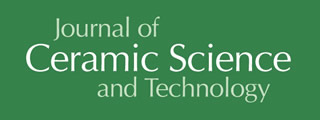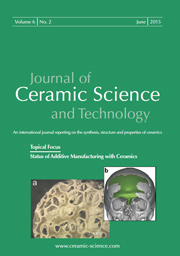Articles
All articles | Recent articles
Synthesis Conditions of Cobalt Aluminate Nano-Sized Powder
Sh. Salem1, S.H. Jazayeri1, F. Bondioli2, A. Allahverdi1, M. Shirvani1
1 School of Chemical Engineering, Iran University of Science and Technology, Tehran 16846 – 13114, Iran
2 Department of Material and Environmental Engineering, University of Modena e Reggio Emilia, Modena 41100 , Italy
received March 20, 2011, received in revised form May 10, 2011, accepted May 25, 2011
Vol. 2, No. 3, Pages 169-178 DOI: 10.4416/JCST2011-00015
Abstract
The effect of the conditions applied for the synthesis of cobalt aluminate powder on the thermal behaviour of a typical transparent frit was investigated. The nano-sized cobalt aluminate spinels were prepared with the combustion method. The powders were synthesized at a pH of 2.5, 7.0, 10.5 and a fuel ratio of 0.56 and 0.75 using cobalt and aluminium nitrates and glycine as fuel. The obtained gels were calcined at 800 and 1000 °C. 2 wt% calcined powders were added to an industrial transparent frit and the thermal behaviour of the modified glazes was studied by means of hot stage microscopy (HSM). The thermal properties are described in terms of height percentage and contact angle. All samples began to shrink close to 700 °C and reached a minimum value at around 1330 °C. The synthesis of powder at acidic and neutral pH with a low content of fuel led to a significant change in the height percentage and an expansion was observed between 940 and 1040 °C. The HSM data were analyzed with the Vogel-Fulcher-Tamman equation and the influence of the synthesis conditions on the molten viscosity was evaluated. The results indicated that the synthesis of cobalt aluminate gel at neutral pH in the presence of a low fuel ratio and calcination at 1000 °C provides the best conditions from an industrial point of view.
![]() Download Full Article (PDF)
Download Full Article (PDF)
Keywords
Cobalt aluminate, glaze; melting, hot stage microscopy, viscosity
References
1 Burdett, J.K., Price, G.L., Price, S.L.: Role of the Crystal-Field Theory in Determining the Structures of Spinels, J. Am. Chem. Soc., 104, 92 – 95, (1982).
2 Li, W., Li, J., Guo, J.: Synthesis and Characterization of Nano-Crystalline CoAl2O4 Spinel Powder by Low-Temperature Combustion, J. Eur. Ceram. Soc., 23, 2289 – 2295, (2003).
3 Ouahdi, N., Guillemet, S., Demai, J.J., Durand, B., Rakho, L.E., Moussa, R., Samdi, A.: Investigation of the Reactivity of AlCl3 and CoCl2 toward Molten Alkali-Metal Nitrates in Order to Synthesize CoAl2O4, J. Mater. Lett., 59, 334 – 340, (2005).
4 Chen, Z.Z., Shi, E.W., Li, W.J., Zheng, Y.Q., Zhuang, J.Y., Xiao, B., Tang, L.A.: Preparation of Nano-Sized Cobalt Aluminate Powders by a Hydrothermal Method, J. Mater. Sci. Eng., 107, 217 – 223, (2004).
5 Melo, D.M.A., Cunha, J.D., Fernandes, J.D.G., Bernardi, M.I., Melo, M.A.F., Martinelli, A.E.: Evaluation of CoAl2O4 as Ceramic Pigments, J. Mater. Res. Bull., 38, 1559 – 1564, (2003).
6 Souza, L.K.C., Zamian, J.R., Rocha F.G.N., Soledade L.E.B., Santos, I.M.G., Souza, A.G., Scheller, T., Angelica, R.S., Costa, C.E.F.: Blue Pigments Based on CoxZn1-xAl2O4 Spinels Synthesized by the Polymeric Precursor Method, Dyes Pigments, 81, 187 – 192, (2009).
7 Sickafus K.E., Wills, J.M.: Structure of Spinel, J. Am. Ceram. Soc., 82, 3279 – 3292, (1999).
8 Nakatsuka, A., Ikeda, Y., Yamasaki, Y., Nakayama, N., Mizota, T.: Cation Distribution and Bond Lengths in CoAl2O4 Spinel, J. Solid State Commun., 128, 85 – 90, (2003).
9 Wang, C., Liu, S., Liu, L., Bai, X.: Synthesis of Cobalt-Aluminate Spinels via Glycine Chelated Precursors, J. Mater. Chem. Phys., 96, 361 – 370, (2006).
10 Ahmed, I.S., Dessouki, H.A, Ali, A.A.: Synthesis and Characterization of New Nano-Particles as Blue Ceramic Pigment, Spectrochim Acta A, 71, 616 – 620, (2008).
11 Mimani, T., Ghosh, S.: Combustion Synthesis of Cobalt Pigments: Blue and Pink, Curr. Sci. India, 78, 892 – 896, (2000).
12 Chen, Z., Shi, E., Li, W., Zheng, Y., Zhong, W.: Hydrothermal Synthesis and Optical Property of Nano-Sized CoAl2O4 Pigment, Mater. Lett., 55, 281 – 284, (2002).
13 Niasari, M.S., Khouzani, M.F., Davar, F.: Bright Blue Pigment CoAl2O4 Nano-Crystals Prepared by Modified Sol-Gel Method, J. Sol-Gel Sci. Technol., 52, 321 – 327, (2009).
14 Segal, D.: Chemical Synthesis of Ceramic Materials, J. Mater. Chem., 7, 1297 – 1305, (1997).
15 Yu, F., Yang, J., Ma, J., Du, J., Zhou, Y.: Preparation of Nano-Sized CoAl2O4 Powders by Sol-Gel and Sol-Gel-Hydrothermal Methods, J. Alloys and Compd., 468, 443 – 446, (2009).
16 Lade, M., Mays, H., Schmidt, J., Willumeit, R., Schomacker, R.: On the Nano-Particle Synthesis in Microemulsions: Detailed Characterization of an Applied Reaction Mixture, Colloid Surface, 163, 3 – 15, (2000).
17 Suchanek, W.L., Riman, R.E.: Hydrothermal Synthesis of Advanced Ceramic Powders, Adv. Sci. Tech., 45, 184 – 193, (2006).
18 Chokkaram, S., Srinivasan, R., Milburn, D.R., Davis, B.H.: Conversion of 2-Octanol over Nickel-Alumina, Cobalt-Alumina, and Alumina Catalysts, J. Mol. Catal. A-Chem., 121, 157 – 169, (1997).
19 Britto, S., Radha, A.V., Ravishankar, N., Vishnu, K.P.: Solution Decomposition of the Layered Double Hydroxide (LDH) of Zn with Al, Solid State Sci., 9, 279 – 286, (2007).
20 Purohit, R.D, Saha, S., Tyagi, A.K.: Powder Characteristics and Sinterability of Ceria Powders Prepared through Different Routes, Ceram. Int., 32, 143 – 146, (2006).
21 Peng, T., Liu, X., Dai, K., Xiao, J., Song, H.: Effect of Acidity on the Glycine-Nitrate Combustion Synthesis of Nano-Crystalline Alumina Powder, Mater. Res. Bull., 41, 1638 – 1645, (2006).
22 Lima, M.D., Bonadimann, R., Andrade, M.J., Toniolo, J.C., Bergmann, C.P.: Nanocrystalline Cr2O3 and Amorphous CrO3 Produced by Solution Combustion Synthesis, J. Eur. Ceram. Soc., 26, 1213 – 1220, (2006).
23 Ahmed, M., Earl, D.A.: Characterizing Glaze Melting Behaviour via HSM, Am. Ceram. Soc. Bull., 81 (3), 47 – 51, (2002).
24 Froberg, L., Kronberg, T., Hupa, L., Hupa, M.: Influence of Firing Parameters on Phase Composition of Raw Glazes, J. Eur. Ceram. Soc., 27, 1671 – 1675, (2007).
25 Siligardi, C., D'Arrigo, M.C., Leonelli, C.: Sintering Behaviour of Glass-Ceramic Frits, Am. Ceram. Soc. Bull., 79 (8), 89 – 93, (2000).
26 Funk, J.E.: Designing the Optimum Firing Curve for Porcelains, Am. Ceram. Soc. Bull., 62 (6), 632 – 635, 1982.
27 Salem, A., Jazayeri, S.H., Rastelli, E., Timellini, G.: Dilatometeric Study of Shrinkage during Sintering Process for Porcelain Stoneware Body in Presence of Nepheline Senate, J. Mater. Process. Tech., 209, 1240 – 1246, (2009).
28 Boccaccini, A.R., Hamann, B.: Review In Situ High-Temperature Optical Microscopy, J. Mater. Sci., 34, 5419 – 5436, (1999).
29 Paganelli, M., Sighinolfi, D.: Understanding the Behaviour of Glazes with the Automatic Heating Microscope, cfi/Ber. DKG, 85 (5), E63 – 67, (2008).
30 Scholze, H.: The influence of viscosity and surface tension on heating microscope measurements on glasses, (in German), Ber. DKG, 39, 63 – 68, (1962).
31 Engels, M., Link, S.: Bubble Control in Ceramic Glazes, Interceram, 55 (3), 152 – 156, (2006).
32 Waal, D.: Raman Investigation of Ceramics from 16th and 17th Century Portuguese Shipwrecks, J. Raman Spectrosc., 35, 646 – 649, (2004).
33 Kock, L.D., Waal, D.: Raman Studies of the Underglaze Blue Pigment on Ceramic Artefacts of the Ming Dynasty and of Unknown Origins, J. Raman Spectrosc., 38, 1480 – 1487, (2007).
Copyright
Göller Verlag GmbH
Acknowledgments
The authors would like to acknowledge the contribution of Dr. S.H. Jazayeri to this research. Unfortunately he passed away one year ago. Iran's scientific society has lost a truly erudite scientist. He is dearly missed by his students and colleagues.


